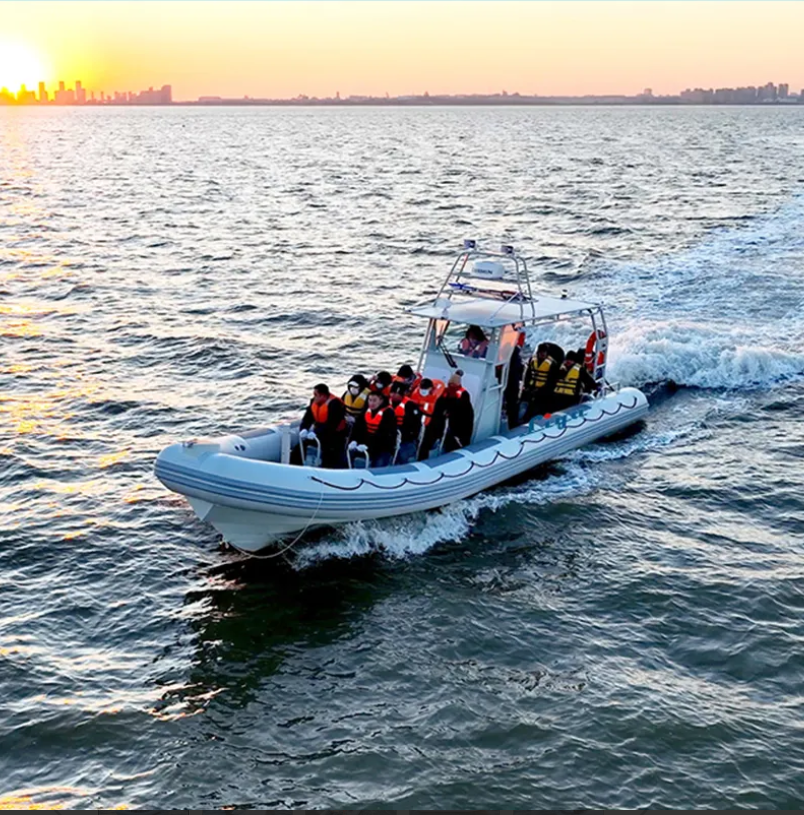Aluminum Rhib Mga Hull: Lakas at Katatagan
Mga Benepisyo ng Aluminio sa Paggawa ng RHIB
Ang aluminum ay nangunguna bilang isang mahusay na opsyon para sa paggawa ng RHIB hull dahil hindi ito madaling korohin, isang mahalagang aspeto lalo na kapag ang mga bangka ay matagal na nasa asin sa dagat. Ang katotohanang ang mga hull na ito ay mas matibay at maaasahan sa loob ng maraming taon ay talagang mahalaga para sa mga sasakyang palagi naming nababasa. Bukod pa rito, ang magaan na timbang ng aluminum ay nagpapahintulot sa RHIBs na lumakad nang mas mabilis habang gumagamit ng mas kaunting gasolina kumpara sa mas mabibigat na alternatibo na kasalukuyang nasa merkado. Gustong-gusto ng mga tagagawa ng bangka gamitin ang aluminum dahil ito ay may mahusay na lakas kung ihahambing sa kanyang magaan na bigat, na nagpapahintulot sa kanila na makagawa ng matibay ngunit madaling pangasiwaan sa magulong dagat. Ano pa ang nagpapaganda sa aluminum? Ang pagkumpuni ay karaniwang mas madali kumpara sa ibang materyales. Ang isang maliit na butas o gasgas sa aluminum hull ay karaniwang mabilis at hindi gaanong mahal na ayusin. Lahat ng mga katangiang ito ang nagpapaliwanag kung bakit karamihan sa mga tagagawa ay nananatiling gumagamit ng aluminum sa paggawa ng seryosong RHIBs na kailangang gumana nang maayos sa ilalim ng presyon.
Mga Limitasyon ng mga Bulkang Aluminio
Maaaring tunog na maganda ang aluminum para sa RHIB hulls, ngunit mayroon din itong ilang mga disbentaha. Ang pinakamalaking problema na kinakaharap ng maraming tao ay kung gaano kadali itong madent at masugatan. Hindi lang ito nakakagulo, kundi nakakaapekto rin ito sa pagganap ng bangka sa tubig. Isa pang dapat isaalang-alang ay ang presyo. Mas mahal ang aluminum kaysa sa ibang materyales sa merkado, kaya maaaring maging hadlang ito para sa mga taong matalino sa badyet. Kapag naman dumating ang oras na mag-weld ng aluminum, mabilis itong maging tricky. Ang maliit na pagkakamali sa pagwaweld ay maaaring magdulot ng malalang problema sa hinaharap kapag nabigo na ang hull sa ilalim ng presyon. Huwag din kalimutan ang mga salik na kumportable. Dahil sa maganda nitong pagkakalikha ng init, ang temperatura sa loob ng bangka ay hindi mapapaglabanan sa parehong mainit na araw ng tag-init at malamig na umaga ng taglamig. Mapapansin ito ng sinumang nagplano ng mahabang biyahe pagkatapos maglaan ng oras sa loob ng bangka. Ang pagkakilala sa lahat ng mga limitasyong ito ay nakatutulong sa mga gumagawa ng bangka at mga customer na pumili ng tamang materyales batay sa kung ano ang pinakamahalaga sa kanila.
Mga Hull ng Fiberglass RHIB: Maaaring Pagsisikap na Maglinaw
Mga Benepisyo ng Fiberglass para sa mga Hull ng RHIB
Karamihan sa mga taong gumagawa ng RHIB ay pumipili ng fiberglass dahil ito ay magaan. Talagang makaiimpluwensya ang materyales na ito sa bilis kung saan makakagalaw ang mga bangkang ito sa tubig. Ang fiberglass ay mayroong katangian na mababang density na nagpapahintulot sa RHIB na mag-drift nang hindi nakikipaglaban sa alon, na nangangahulugan na mas mababa ang konsumo ng patakaran. At may isa pang benepisyo. Hindi lang ito maganda para sa bilis. Ang fiberglass ay mayroon ding magandang katangian na pang-insulate laban sa ingay. Ibig sabihin, hindi masyadong maingay ang tunog ng makina para sa mga taong sakay ng bangkang ito. Mas pinahahalagahan ng mga pasahero ang tahimik na biyahe kaysa sa kanilang inaakala.
Napakatangi ng fiberglass pagdating sa kadalian ng paghubog nito. Gustong-gusto ng mga tagagawa ng bangka ang materyales na ito dahil maaari silang lumikha ng iba't ibang disenyo ng bangka na hindi posible sa ibang materyales. Ang mga fiberglass RHIB ay mayroong iba't ibang hugis at sukat, mula sa makinis na racing model hanggang sa matibay na offshore version, bawat isa ay idinisenyo para sa tiyak na gawain o itsura na ninanais ng mga tao. Isa rin sa mga bentahe nito ang pagpapanatili. Hindi katulad ng mga metal na bangka na palagi nangangalaga sa kalawang at pagkaubos, ang fiberglass ay walang ganitong mga problema. Karamihan sa mga may-ari ng bangka ay nakakapaglaan ng mas kaunting oras sa pagkumpuni at paglilinis sa paglipas ng mga taon, kaya naman matalinong pagpipilian ang fiberglass para sa sinumang nais magkaroon ng bangka nang ilang dekada at hindi lamang ilang panahon.
Mga Kakulangan ng Mga Material na Fiberglass
Tunay na may mga kakahuyan ang fiberglass, ngunit mayroon din itong ilang mga kahinaan kapag tinamaan ng malakas o nabanggaan ang mga bangka. Hindi gaanong matibay ang materyales laban sa matutulis o mabibigat na pag-impact, at maaari nitong siraan ang istruktura ng katawan ng bangka kung hindi kontrolado. Habang tumatagal ang panahon, nagsisimula ring lumitaw ang isa pang problema. Minsan, naghihiwalay ang mga layer ng fiberglass na kilala ng mga taong may bangka bilang delamination. Dahil dito, nabawasan ang haba ng buhay ng bangka at naapektuhan ang kanyang pagganap sa tubig. Ang mga may-ari ng bangka na nakakaranas ng mga problemang dulot ng impact at unti-unting pagkasira ay kadalasang nagtatapos sa paglaan ng dagdag na oras at pera upang maiwasan ang pinsala at ayusin ang mga nasirang bahagi.
Ang environmental footprint ng paggawa ng mga produkto mula sa fiberglass ay tiyak na isang bagay na kailangang isipin mula sa pananaw ng sustainability. Kung ikukumpara sa ibang alternatibo, ang proseso ng produksyon ay kadalasang kasangkot ang mga materyales at teknik na hindi gaanong nakikinig sa kalikasan. Hindi rin madali ang pagrerepair ng fiberglass na bangka. Mas mahaba ang kinakailangang oras kumpara sa pagrerepair ng mga hull na gawa sa metal. Kadalasan, kailangan din ng mga espesyal na kagamitan at kaalaman, na nangangahulugang dagdag gastos at abala sa hinaharap. Mayroon namang mga bentahe ang fiberglass. Gayunpaman, ang sinumang naghahanap ng materyales para sa konstruksyon ng RHIB hull ay dapat magbantay ng mga disbentaheng ito laban sa mga benepisyong maaaring makamit bago magdesisyon.
Mga Materyales ng Casco ng Composite at PVC: Karaniwaan at Pag-unlad
Mga Benepisyo ng mga Casco ng Composite/PVC ng RHIB
Pagdating sa mga RHIB hull na gawa sa composite at PVC materials, walang duda kung bakit maraming mga boat operator ang umaasa sa kanila para sa iba't ibang uri ng mga aktibidad sa tubig. Naaangat ang mga bangkang ito dahil pinagsasama nila ang tunay na tibay at nakakagulat na kakayahang umangkop, isang katangiang talagang nagpapakaiba sa kanila habang nalalayag sa magaspang na dagat o bato-bato sa baybayin. Ang paraan kung paano gumagana nang magkasama ang mga materyales na ito ay lumilikha ng mga hull na mas magaan ngunit nananatiling lubhang matibay, na nangangahulugan ng mas mahusay na bilis at mas mababang gastos sa gasolina sa kabuuan. Isa pang malaking bentahe ay ang kanilang paglaban sa kalawang at pinsala mula sa araw. Maraming karaniwang bangka ay nagsisimulang magpakita ng pagkasuot pagkalipas lamang ng ilang panahon, ngunit ang composite at PVC hulls ay nananatiling maganda sa kabila ng mga taon nang hindi nangangailangan ng paulit-ulit na pagkukumpuni. Ang mga gumagawa ng bangka ay naging malikhain din, nagdidisenyo ng mga bagong hugis at istruktura na talagang nagpapabuti sa pagmamaneho. Ang ilang mga modelo ngayon ay may mga espesyal na kontor na tumutulong sa pagpanatili ng balanse kahit sa mga magaspang na kondisyon, na nagbibigay ng higit na kumpiyansa sa mga operator habang nasa di inaasahang mga sandali sa tubig.
Kontra ng Paggamit ng Kompositong/PVC Materyales
Ang mga materyales na komposit at PVC ay mayroon talagang mga bentahe, ngunit mayroon ding ilang mga disbentahe na nararapat banggitin para sa sinumang nasa proseso ng pagbili nito. Ang mga produkto na komposit ay karaniwang mas mahal kaysa sa ibang alternatibo, kaya baka hindi ito angkop sa badyet ng lahat. Ang mataas na presyo nito ay sapat na dahilan para mawala ang interes ng maraming taong maingat sa kanilang mga gastusin. Kapag may problema sa mga hull na gawa sa komposit o PVC, hindi rin madali ang pagkumpuni nito. Kadalasan, nangangailangan ito ng espesyal na kagamitan at kaalaman na hindi laging madaling makita sa lahat ng lugar. Mayroon ding mga isyung pangkapaligiran na dapat isaalang-alang sa proseso ng paggawa nito. Ang produksyon ng mga materyales na ito ay nagbubunga ng basura at nangangailangan ng malaking dami ng enerhiya. At katunayan, kahit na ang mga hull na komposit at PVC ay nakakatagal sa normal na kondisyon, hindi pa rin ito makakatumbas sa tradisyunal na mga materyales kapag sobrang matindi ang kondisyon sa tubig. Para sa mga taong balak gamitin ang bangka sa mga mapigting lugar, maaaring pagkaiba ito ng karanasan mula sa isang maayos na paglalayag papunta sa malubhang problema sa hinaharap.
Pagpili ng Tamang Anyo ng Hull ng RHIB
Pagsusuri ng Katataguan laban sa Timbang
Ang pagpili ng tamang materyales para sa RHIB hull ay nangangahulugan ng paghahanap ng magandang balanse sa pagitan ng lakas nito at bigat nito. Ang pagkuha ng tamang timpla ay nagpapakaibang epekto sa pagganap sa iba't ibang gamit ng RHIB. Ang mga bangkang pang-rescue ay nangangailangan ng iba kung ano ang pinakamabuti para sa mga militar na sasakyan, kaya mahalaga na maintindihan ang mga tiyak na pangangailangan sa operasyon. Ang mga ginagamit sa paggawa ng hull ay nakakaapekto hindi lamang sa bilis ng bangka kundi pati sa pagtaya nito sa ilalim ng presyon. Iyon ang dahilan kung bakit mahalaga na matalino ang pagpapasya dito, na nangangailangan ng sapat na oras at pag-iisip. Talagang nakakatulong ang pakikipag-usap sa mga taong may karanasan sa larangan dahil nakita na nila kung ano ang talagang gumagana sa tunay na karanasan at hindi lamang sa teorya. Ang payo nila ay nanggaling sa praktikal na pagsubok at hindi lamang sa aklat.
Mga Pagtaas at Bawas sa Gastos at Paggamot
Ang pera ay mahalaga kapag pumipili ng materyales para sa RHIB hull. Kailangang tingnan ng mga may-ari ng bangka ang kanilang maaaring gastusin sa una at ang mga gastos sa pagpapanatili nito sa hinaharap. Ang ilang mga materyales ay mas mahal sa una, ngunit karaniwang nakakatipid ng pera sa matagalang paggamit dahil sa kanilang tagal bago masira. Ang maayos na pangangalaga ay nakatutulong din upang mapahaba ang kanilang buhay. Mahalaga rin ang pangalawang merkado sa pagpapasya dahil ang ilang materyales ay nananatiling may mataas na halaga, samantalang ang iba ay mabilis na bumaba ang halaga. Oo, maaaring mahal ang pagbili ng mas matibay na materyales sa una, ngunit karaniwan namang nakakatipid ng malaking halaga ang mga gumagamit nito sa paglipas ng panahon dahil sa kakaunting pagkumpuni at pagpapalit na kinakailangan.
Seksyon ng FAQ
Ano ang mga pangunahing benepisyo ng paggamit ng aluminio para sa mga hull ng RHIB? Nakakapaloob ang aluminio ng resistensya sa korosyon, mahahalingwatawat na katangian, at kinalaman sa pagsasanay, gumagawa ito ng isang malakas na pili para sa paggawa ng hull ng RHIB.
Paano humahambing ang fiberglass sa aluminio sa aspeto ng maintenance? Kailangang magkaroon ng mas mababang pamamahala ang fiberglass dahil sa kanyang resistensya sa karos at korosyon, sa halip na aluminum na maaaring kailanganin ng madalas na pagsusustena upang iwasan ang pagdudulo at pagsisirad.
Sapat ba ang mga composite at PVC hull para sa ekstremong kondisyon? Habang maaayos ang pagganap ng mga composite at PVC hull sa pangkalahatang kondisyon, maaaring hindi laging katumbas ang kanilang pagganap sa tradisyonal na mga material sa ekstremong kapaligiran.
Ano ang dapat intindihin sa pagpili ng mga materyales ng RHIB hull? Mga mahalagang paktorya ay kasama ang katatagan, timbang, mga unang gastos, pamamahala sa haba-haba ng panahon, at mga partikular na operasyonal na pangangailangan.

